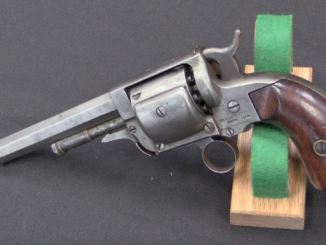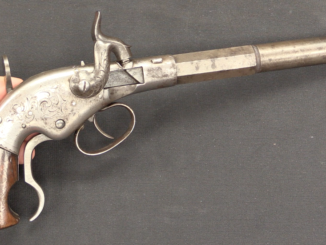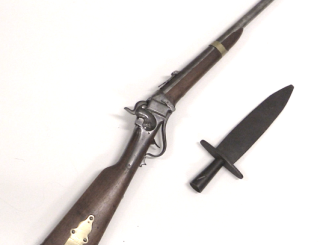I’m at the SHOT Show in Las Vegas today (and the rest of the week), and when you read this I will probably be desperately trying to wade through the sea of AR15s in search of something interesting. 🙂 At any rate, I figured you might get a kick out of the most recent video Karl and I have published on InRange TV: mud testing a couple rifles. This was initially going to be just M1A vs MAS 49/56 to see how the much-underappreciated MAS performed compared to the oft-deified M1A. At the last minute Karl brough along an AR, though, so we put it through the wringer too, and I’m glad we did.
Some of the results were what I expected, but some elements did surprise me. Have a look for yourself:
A few details, for those who are interested:
The MAS was in the original 7.5 caliber, and I was using new Prvi ammo in it.
The M1A was using Wolf .308. We dumped a mag through it with no problems prior to the test.
The AR was using XM-193 ammo.
Happily, my romp in the mud did not result in any parasites, rashes, or other health problems. Likewise, all three guns cleaned up just fine, although it took several hours to get them un-muddied.
We also did sand testing with all three guns, which will be publishing in 2 weeks. A Part II to the testing using AKs is planned for filming in the coming months.




I think you have just proven the fact that an open action with looser tolerances that allows ingress of foreign matter to the action is inferior to a relatively tighter tolerance action which prevents foreign matter from entering. I think this is the secret of the Glock handgun’s seemingly legendary reliability. If you look at a glock action, there are relatively few areas where things can enter the action and bind up the works, whereas weapons like a 1911 have a large open area directly above the fire control group (when the hammer is cocked) that allows items to enter the action. Same thing with the AR, it has tight tolerances around the ejection port, receiver halves and trigger hole that allow very minimal ingress to foreign matter, thus improving the weapon’s reliability under extreme conditions. The M1A has a huge open top on the receiver and large open areas around the bolt and op rod that allow anything to get into the moving parts of the action to bind it up. Im willing to bet that an AK with the selector in the fire position would also be inferior in reliability to an AR with the ejection port cover open under identical situations simply due to the fact that foreign matter can enter the action of the AK, and it cannot in the AR. It doesn’t matter if you have sloppy tolerances in your action, if the foreign matter is larger than those tolerances. Excellent post!
Is the good performance of the AR partly due to the gas system having a “self cleaning” effect by blowing crud out of the action?
Any ‘gas system self cleaning’ would effect the MAS as well as the AR.
Good luck at shot show, are the FG 42 people there this year? maybe a nice MOLLE, or Para shoot cord hair tie? Or someone to make you an indirect fire app for your Vickers?
Yes the MAS also might be benefiting from that “self-cleaning” process of gas entering the action. I suppose a high-speed of the rifles firing when mud-caked might shed some light.
This is actually a very good point and something that I have kicked around in my head in the past, but haven’t anywhere posted for fear of getting eaten alive. I think you’re onto something, but it’s also sort of a Catch-22.
I think you make a lot of good points about the openness of the AK, but I also think that neither of us will deny that once a ton of goop gets into the rifle it will deal with this better than an AR. What the ‘Inconvenient Truth’ is for a lot of people is that if you keep letting mud get into your AK, it will die on you eventually. As we saw with Ian’s video, two major issues are the bolt not going back far enough to recock the rifle and the trigger getting stuck and ceasing to work. I think the openness of the AK will allow this to happen a lot more to the Kalashnikov than it will the AR.
An AR, on the other hand, will likely die sooner than the AK if you let mud into it but as we saw with Ian’s testing, it’s hard for mud to get in there.
I don’t see it like this. You’ve got 2 different way of managing dirt in a mechanical system. Find a way to get the dirt out or seal the system. Both method are valid but you can’t make a little of both.
Glock pistols are clearly “open” design with gap everywhere to let the dirt flow through the system.
Don’t walk through any dark alleys , there’s a horde of fanatics out there trying to get you for blasphemy (btw you should do that test with Glock vs 1911, just in case there is someone left whom you haven’t offended).
I think Karl is already on the blacklist of many of his fellow Americans for revealing that he likes the P38 much better than the M1911…
Ian;
While I realize that this forum is primarily about military weaponry, I was wondering if you might be willing to do a post on the American 180 sub machine gun? This firearm was supposedly kept in inventory by some prison systems as a riot control weapon (not sure if that is accurate or merely disinformation). At any rate it supposedly was reliable in automatic fire and was never available to the public. I believe it would be an interesting post. Just a suggestion. Thanks for your interesting blog site.
George
George,
Not to step on Ian’s prerogative to reply, the American 180 was available and sold to the public while it was on the market, although it was always an NFA weapon. Later, there was a semi version.
There was a concerted effort to sell it as a police and military weapon, on the theory that it could deliver the whole 177 rounds from its pan in ~8 seconds. Assuming a 30-gr HP as the .22 round, that’s ~5300 grains on target, while a TSMG with a 30-round stick could beat that (~7000) and a 50-round drum more than double it). Not to mention that penetration is vital to man stopping. (As hunters have long known about game stopping). It was always a novelty more than a combat weapon.
It was the earliest use of a visible laser sight as a regular option on any firearm, IIRC.
I knew they made the MAS in 7.5 mm but I didn’t know they made them as tiny as 7.5 caliber. Must have been devastating on houseflies.
Uh, houseflies? An actual 7.5 caliber, as it was written, is literally a cannon, and not a small one; .75 caliber is common for muzzleloaders and between a 10 and 12 gauge shotgun; and going all the way down to .075 would make it a genuinely tiny cartridge, but the decimal point has to be in the right place, because all ‘caliber’ means is what portion of an inch is being discussed. You don’t move it over two places- everyone might understand what you mean when you say ‘Forty five caliber’ but that’s the wrong way to write it down and you’d be more correct to say ‘Point four five caliber’ verbally.
I suspect a misunderstanding about bullet diameter.
MAS 7.5mm x 54mm ammunition is closer to standard NATO rifle ammunition (7.62mm x 51mm) than a .22 Long Rifle (5,5mm x 15mm)
…and 7 gauge would be close to 23mm…
My faith in the Garand style receiver is shattered. Alas! I wonder were I can find a used MAS 49/56. I found the comment about the forward assist being a “jam enhancer” interesting. When Uncle Sam loaned me an M16A1 back in the ’70’s I could never quite figure out what that thing was supposed to do, because I never managed to accomplish anything with it.
Great vid. Looking forward to the AK’s.
The forward assist was invented as a solution to a problem that no longer exists. When the M16 was originally adopted, there was the well known problems with corrosion in the chambers and the powder dumping a lot more gunk into the action than it should have. The forward assist was phased in so that soldiers could smack the rifle into battery because ‘failure to battery’ malfunctions were extremely common with the early M16 and were difficult to clear with the charging handle.
This problem was basically fixed with the M16A1, but the forward assist has remained on that rifle as well as all M16/M4 pattern weapons adopted since. Now that failure to battery malfunctions are so uncommon with the rifles, the forward assist in my experience is usually used on double feeds which indeed almost always does make them worse.
I am torn as to weather I want the forward assist eliminated from the rifle, but I certainly would like to see much less trust put into it and see training move away from ‘hit this when the rifle stops working no matter what.’
Cheers!
Just for comparison – how would a bolt gun fair in such circumstances? Naively one thinks “better” – but it sure seems that cycling the bolt on a mauser or springfield might well drive muck into the gun.
Before this passing fad of self loading rifles began there were serious debates over the reliability of the various bolt actions.
You can nearly literally take any modern comparison between two guns and copy paste an old gun’s name in and get the same article.
IIRC,
I think US Army wanted the forward assist prior to the corrosion issues. The USN wanted to do what the Army wanted, the USMC did not care and the USAF did not want the forward assist. (my memory is not the best) Rene Stutler also found fault with with the FAL/T48 not having one. R. Blake Steven’s doctoral thesis, The Great Rifle Controversy talks about it and The Black Rifle also talks about this strange appendages’ development. It is the Appendix of the AR world. I never used the forward assist in all my years of service as well. My theory is that SPORS is not as catchy as SPORTS as an acronym.
Maybe this topic may result in another interview of Mr. Sullivan…
The forward assist is also useful if you have to ride the charging handle forward instead of letting the spring run it. Say, if you’re doing a chamber check.
Or, when I was in Basic, we were taught that if we had to ford with the M16, once out of the water crack open the action slightly to let water drain from the muzzle. Then tap the forward assist to ensure the bolt reseats.
i found an interesting video, MP44 in syria :
http://oruzjie.ho.ua/2013/FSA_Sturmgewehr-44.mp4
http://militaryreview.su/113-shturmovaya-vintovka-shturmgevr.html
remote control mp44
http://militaryreview.su/uploads/posts/2013-12/1388367931_398.jpg
http://militaryreview.su/uploads/posts/2013-12/1388368058_stg-44.jpeg
Nice comparison to throw in the MAS which really is in the “forgotten” category, yet a fairly decent weapon.
Any chance of an AK-47 vs. CZ58 vs. SKS matchup? What the heck, there must be Rashid floating around somewhere to throw in.
I loved the bit where Ian seemingly tried to blow some of the mud off the Mas.
Great video though.
How about a second round of mud and rifle testing, adding the AK, and SMLE’s, and FAL. And adding an additional test, where you crawl thru the mud, then remove the magazine, and swish the locked open action in standing water to rinse out the mug and guck?
I recall reading that the M1 Garand was tested by the British, at some point, and found to be prone to failure in “battlefield conditions.” I had always thought that it was likely rejected for political/financial reasons, but perhaps they also tried to fill it with mud? The British seemed to have been obsessed with the idea of having to re-fight Passendale, just look at their heavy tank designs. Anyway not that I want to see Ian drag an M1 through the mud (that’s a lie I actually really do), but i wonder if the long stroke gas system wouldn’t help? Maybe the short stroke of the M14 isn’t transferring enough energy to the action to dislodge the mud the way the Mas seem to be doing? I suppose I just have a hard time believing that if it were so prone to jamming in the mud that it wouldn’t have been a more well known fact. I’ve always done my best to speak with WWII and Korean war vets when possible (too few left these days) and they never have a negative thing to say about the rifle (other guns yes). Perhaps heavy mud just wan’t a common problem, or maybe good training prevailed and they kept them clean. Anyway enough rambling from me, great vid!
I suspect the skeletonized stock Ian had on the rifle had something to do with it, considering the failures were caused by mud binding up the op-rod. I am no expert on the M14’s exact mechanical setup, but if moving parts under the barrel of the rifle are exposed by the Troy stock which were intended by the designers to be sealed inside a traditionally-designed stock there’s your failure mechanism right there.
Which I suppose just goes to show that not every cool “tactical” accessory is necessarily an improvement to the original design.